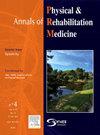蛛网膜下腔出血后社会认知和行为问题持续存在:一项纵向队列研究
IF 4.6
3区 医学
Q1 REHABILITATION
Annals of Physical and Rehabilitation Medicine
Pub Date : 2025-08-21
DOI:10.1016/j.rehab.2025.102015
引用次数: 0
摘要
背景动脉瘤性蛛网膜下腔出血(aSAH)和血管造影阴性蛛网膜下腔出血(anSAH)可导致社会认知和行为问题,潜在地影响社会参与。目的探讨aSAH和anSAH慢性期患者社会认知和行为的长期发展过程及其对社会参与的影响。方法在这项纵向、前瞻性队列研究中,在SAH后3-6个月(T1)和2-4年(T2)进行神经心理评估。社会认知通过情绪识别测试(FEEST)和心理理论测试(卡通测试,失礼测试)来测量。社会行为问题的评估使用来自执行障碍问卷(DEX-Soc)的社会行为项目,由参与者和被调查者打分。冷漠的评估采用冷漠评估量表(AES)的自评版和自评版。社会参与评估采用角色恢复表(RRL)。结果纳入81例SAH患者(59例aSAH和22例anSAH)和60例年龄、性别和教育程度相匹配的健康个体。在T1时,aSAH参与者在FEEST (P = 0.001)和卡通测试(P < 0.001)上的表现明显差于健康个体,在T2时没有明显改善。患有anSAH的参与者在T1时没有表现出社会认知的缺陷,并且随着时间的推移,他们的得分保持稳定。aSAH参与者的行为问题保持稳定,而anSAH组的社会行为问题(dex - soc - 1)随时间增加(P = 0.003)。在总SAH组中,较低的FEEST分数与较高的AES-I分数在两个时间点相关(r = - 0.26),而较差的卡通测试分数仅在T1与AES-I相关(r = - 0.25)。T1时的行为问题与T2时社会参与减少有关,而与社会认知无关(r = 0.24-0.31)。结论aSAH后社会认知障碍持续存在,而行为问题可能加重,且与长期社会参与有关。本文章由计算机程序翻译,如有差异,请以英文原文为准。
Social cognition and behavioral problems persist after subarachnoid hemorrhage: a longitudinal cohort study
Background
Aneurysmal subarachnoid hemorrhage (aSAH) and angiographically negative subarachnoid hemorrhage (anSAH) can result in problems in social cognition and behavior, potentially affecting societal participation.
Objectives
To assess the long-term course of social cognition and behavior, and their impact on societal participation in the chronic stage following aSAH and anSAH.
Methods
In this longitudinal, prospective cohort study, neuropsychological assessments were conducted at 3–6 months (T1) and 2–4 years (T2) after SAH. Social cognition was measured using tests for emotion recognition (FEEST) and Theory of Mind (Cartoon Test, Faux Pas Test). Social behavioral problems were assessed using items on social behavior from the Dysexecutive Questionnaire (DEX-Soc), rated by both participants and informants. Apathy was assessed using self- and informant-rated versions of the Apathy Evaluation Scale (AES). Societal participation was evaluated with the Role Resumption List (RRL).
Results
Eighty-one participants with SAH (59 aSAH and 22 anSAH) and 60 age-, sex-, and education-matched healthy individuals were included. At T1, participants with aSAH performed significantly worse than healthy individuals on the FEEST (P = 0.001) and Cartoon Test (P < 0.001), with no substantial improvement at T2. Participants with anSAH showed no deficits in social cognition at T1, and their scores remained stable over time. Behavioral problems in participants with aSAH remained stable, while informant-rated social behavioral problems (DEX-Soc-I) in the anSAH group increased over time (P = 0.003). In the total SAH group, lower FEEST scores correlated with higher AES-I scores at both time points (r = −0.26), while worse Cartoon Test scores correlated with AES-I at T1 only (r = −0.25). Behavioral problems at T1, not social cognition, were associated with reduced societal participation at T2 (r = 0.24–0.31).
Conclusion
Social cognition impairments after aSAH persist over time, while behavioral problems may worsen after anSAH and are related to long-term societal participation.
求助全文
通过发布文献求助,成功后即可免费获取论文全文。
去求助
来源期刊

Annals of Physical and Rehabilitation Medicine
Medicine-Rehabilitation
CiteScore
7.80
自引率
4.30%
发文量
136
审稿时长
34 days
期刊介绍:
Annals of Physical and Rehabilitation Medicine covers all areas of Rehabilitation and Physical Medicine; such as: methods of evaluation of motor, sensory, cognitive and visceral impairments; acute and chronic musculoskeletal disorders and pain; disabilities in adult and children ; processes of rehabilitation in orthopaedic, rhumatological, neurological, cardiovascular, pulmonary and urological diseases.
 求助内容:
求助内容: 应助结果提醒方式:
应助结果提醒方式:


